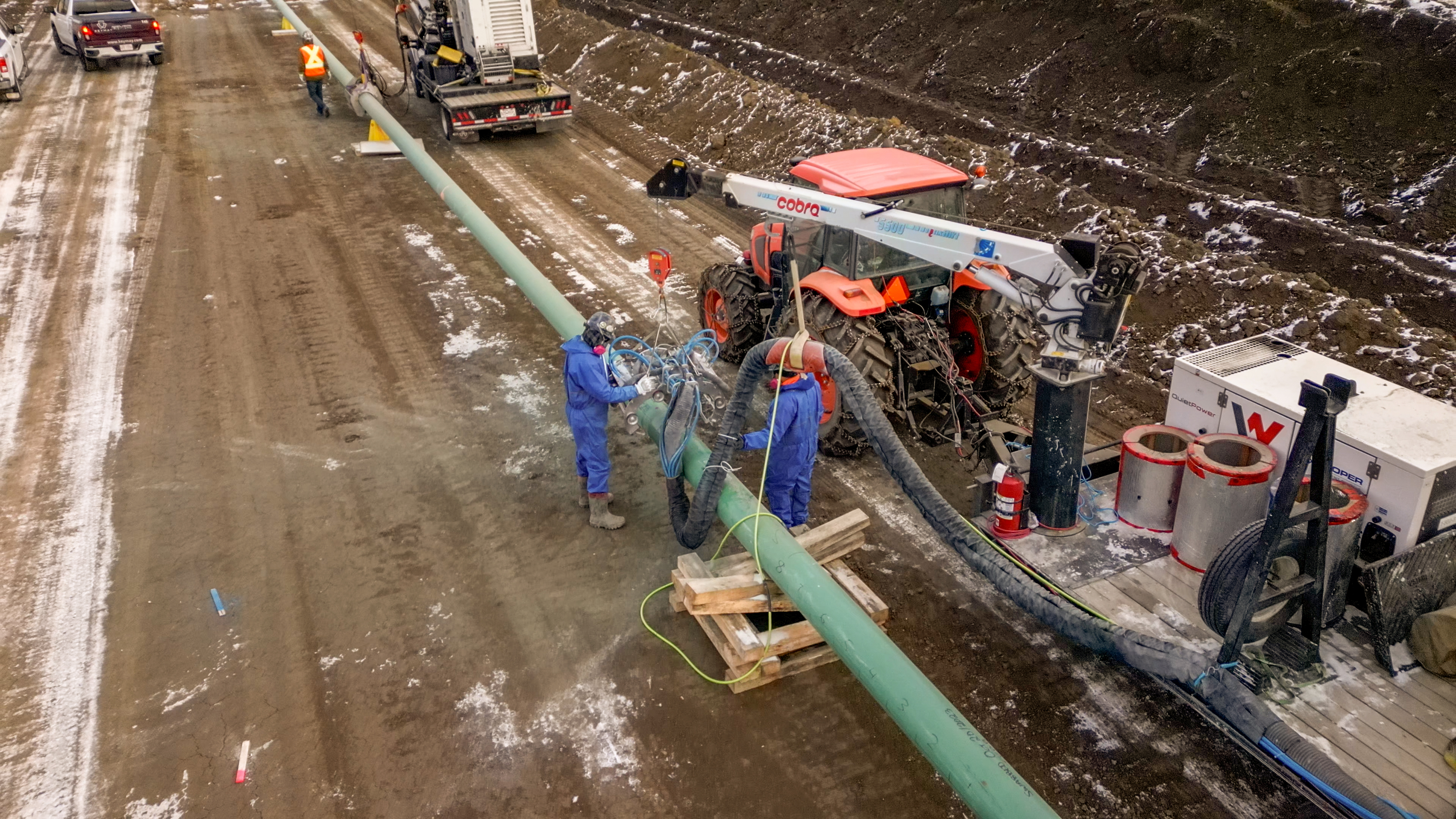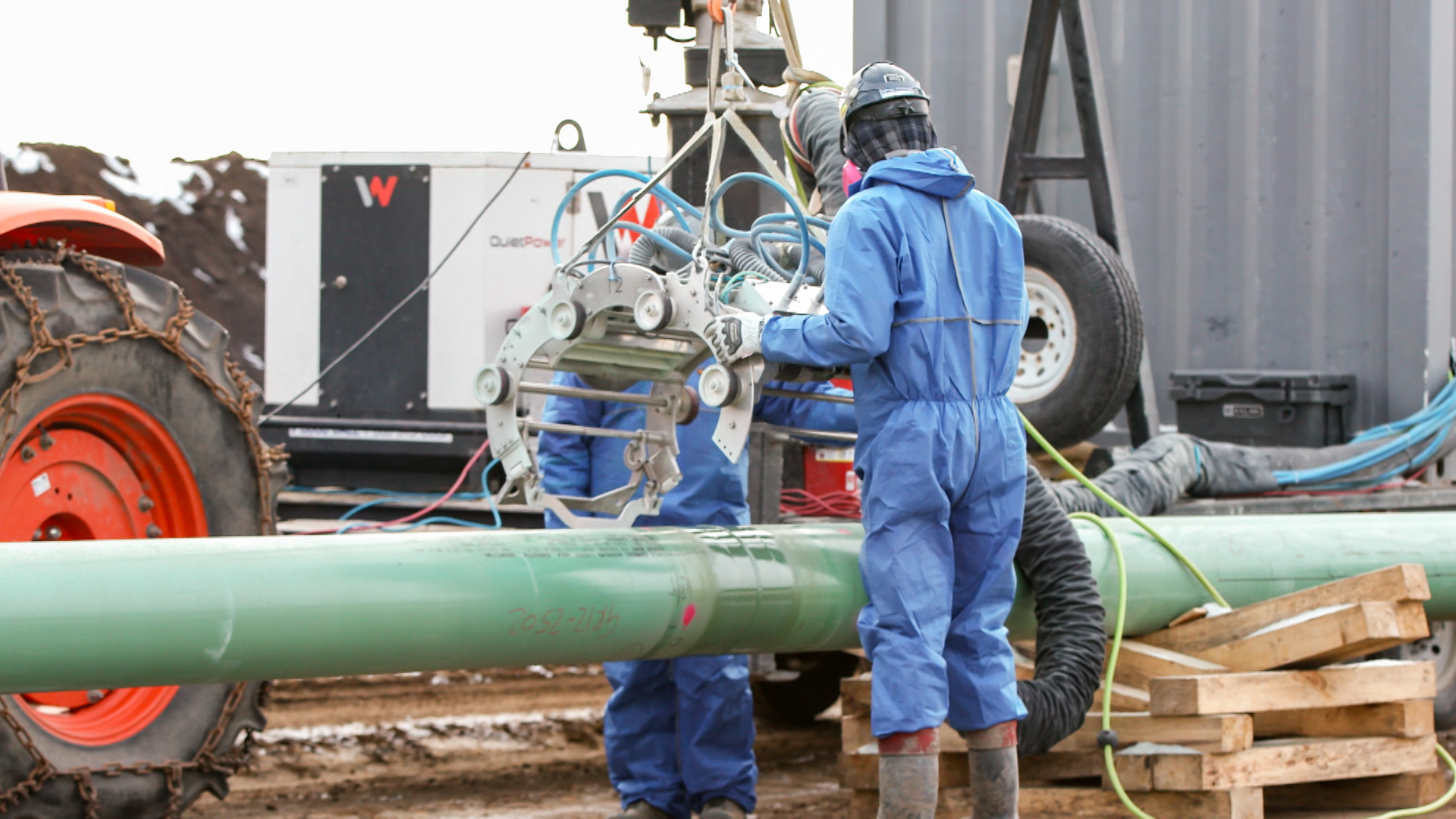October 2024, Vol. 251, No. 10
Features
Building a Better Mousetrap for Coating Pipeline Girth Welds
By Tara Chahl, Technical & Field Service Manager, KEYMAY Industries
(P&GJ) — The pursuit of building a better mousetrap can often pay off in big ways in terms of efficiencies.
Such a productivity payout was the goal for finding a better solution for coating pipeline girth welds in the field – a solution that would speed up the coating process per weld. The low-application temperature (LAT) powdered fusion-bonded epoxy (FBE) coating that was developed as a result of this quest did just that, enhancing project efficiencies while also lowering costs and improving sustainability.
Development of the novel, time-saving technology started with a simple idea and request. Results in the field have repeatedly proven the value of that inquiry.
Initiating Pursuit
Pipeline installers have several options for coating girth welds in the field, including applying polymeric wraps, liquid coatings or FBEs, with a range of manual and automated application methods possible. Each system has its merits, with numerous variables – including the number of welds to coat, the terrain, site access, environmental conditions and more – pointing to optimal options for particular situations. Some projects even use a combination of methods.
Automated FBE girth weld applications offer the most economy in a variety of scenarios. The sweet spot is when pipeline installations cover long distances in reasonably accessible areas. Installers can create an assembly line flow from welding to surface prep to coating applications to inspections, creating a fast-paced operation capable of coating up to roughly 60 welds per day on a 16-inch diameter pipeline using conventional FBE coatings (Figure 1).

That’s a strong pace. However, KEYMAY Industries wondered if that rate could be accelerated if installation crews did not need to heat the welded pipe area all the way to 450° F (232° C) or higher as required when applying conventional FBEs.
This high temperature is necessary to enable the powdered FBE material to melt into a liquid upon contact with the heated steel and flow easily across the girth weld area. A lower application temperature FBE option would allow KEYMAY to reduce the time required to heat areas around pipe welds, enabling installers to move faster from weld to weld.
Additional benefits would be likely as well, but the faster application speed would be especially noteworthy for accelerating pipeline projects, particularly when coating girth welds in the cold winter months.
Answering the Call
As a trusted supplier and service provider to the pipeline and civil construction industries, KEYMAY understands the challenges associated with field coating pipeline girth welds. That in-depth knowledge prompted the company to ask Sherwin-Williams Protective & Marine about developing an FBE with a lower application temperature.
The coatings supplier turned to its research and development lab to modify its FBE molecule to enable the powdered material to melt at a lower temperature. Lab and field testing of the PipeClad® 2000 LAT material followed to confirm the results.
In KEYMAY’s field trials, installers only had to heat pipe weld areas to about 365°
F (185° C), a reduction of 85° F, or 47° C, from the 450° F (232° C) temperature required for conventional FBE applications. Ultrasonic testing and holiday inspections following applications confirmed proper film builds and holiday-free coverage (Figure 2).

Adhesion testing also demonstrated that the new material adhered to pipe substrates as well as the previously used conventional FBEs, with the adhesion strength consistently exceeding 3,000 psi. That adhesion was better than that realized when using liquid epoxy coatings for girth welds, as the FBEs applied in the field are the same general materials used to coat pipes in the shop before they reach the installation site.
Being the same material, the field-applied FBEs are able to bond cohesively with the shop-applied FBEs, forming a strong, monolithic bonding matrix that exceeds the tensile strength of the pipe.
Coating certifications with key standards organizations followed, enabling KEYMAY to confidently use the new technology on projects.
Fielding the Results
The first opportunity for KEYMAY to use the new LAT FBE was in 2021 on the 357-mile (575-km) Key Access Pipeline System (KAPS) project that now moves natural gas liquids (NGLs) and condensate through Alberta’s Industrial Heartland in northern Canada.
Installers completed more than 35,000 girth weld coatings from summer 2021 to winter 2023 using the automated LAT FBE application process for the pipeline (Figure 3). That includes about 10% of the pipe length featuring dual-layer LAT FBE applications, as those sections required an abrasion-resistant overcoat (PipeClad 2040 FLEX LAT) to mitigate any damage associated with their installation via horizontal directional drilling.

Much of the girth weld coating activities took place during winter, bringing the typical cold weather challenge of ensuring the pipes retained sufficient heat between the warming process and FBE application to properly melt the powdered material on contact. That timing actually helped to prove the benefits of using LAT FBEs instead of conventional FBEs, as the lower application temperatures were not only faster to reach, but also easier to maintain before applying coatings.
The faster heating times meant installers could begin LAT FBE applications sooner, accelerating the entire process (Figure 4). Because powdered FBEs fully cure very rapidly, installers were able to inspect the coated areas within minutes of applications, performing holiday testing to ensure complete pinhole-free coverage. Repair needs were minimal, totaling less than 1% of the thousands of girth welds for the project.

Pipeline contractors could then commence backfilling immediately after inspector approvals. This fast pace enabled installers to coat a project record of 138 field joints in one shift, on Feb. 26, 2022. On average, during winter construction, KEYMAY is capable of doubling daily production using the LAT FBE coating compared to the average pace realized with conventional FBEs (Figure 5).

Shorter pipe heating times and faster installations also carry the benefits of cost reductions related to both energy consumption and labor. With less heat required, installation crews are able use less diesel fuel to run the generators that power an induction coil for heating pipes, as well as heaters that control the environment inside the application enclosure that’s used to protect the coating process from the elements.
Additionally, the faster pipes are able to be heated, the sooner applicators are able to finish coating, enabling them to complete more welds per day and achieve faster overall project completions for less total labor hours – and cost – per project.
The lower heating requirements and fuel reductions associated with using LAT FBEs for coating girth welds also translate to more sustainable operations, as fewer emissions are generated on each project.
Paying Off
KEYMAY has continued using LAT FBE technology on a variety of projects, completing more than 50,000 girth weld coating applications since 2021 – still with only 1% of applications requiring any sort of coating repair. The faster applications and reduced heating requirements enabled by the material have delivered notable cost savings, as well as sustainability benefits. As such, the company’s simple request to Sherwin-Williams has resulted in a better mousetrap – and a better payout – for a variety of pipeline girth weld coating projects.
Author: Tara Chahl is a technical & field service manager for Key-May Industries Ltd. With more than 14 years’ experience in coatings, she is responsible for leading specialized crews by training and developing a team of skilled trades in Alberta’s Energy Sector. She also works with Research & Development, creating and implementing custom test procedures for innovative technology.





Comments